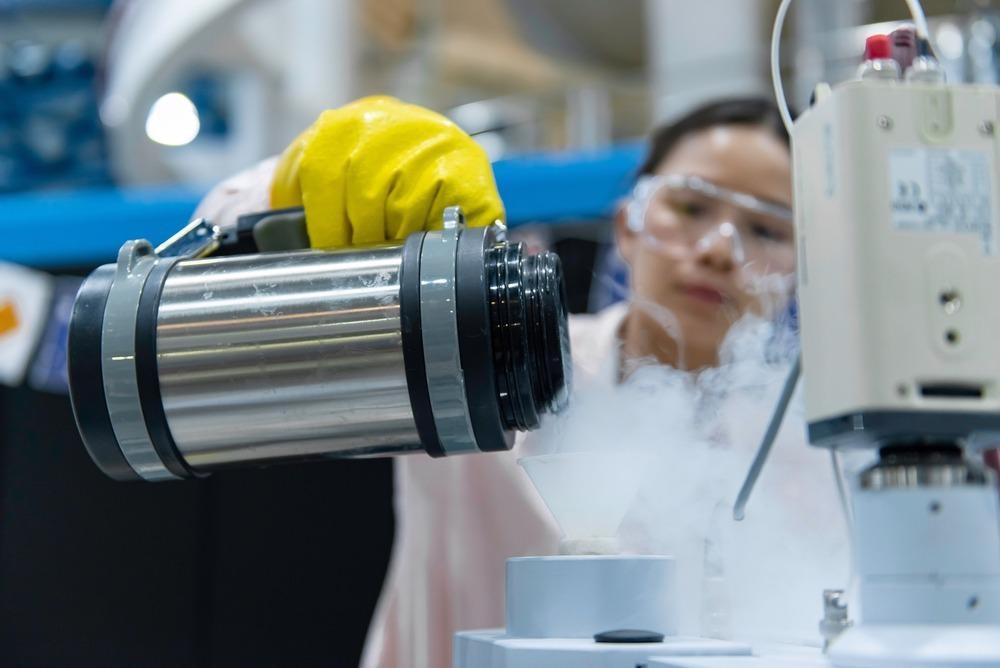Cryogenic metal treatment is used to create or enhance properties in metals and alloys. In 2021, a new technique was developed for the cryogenic treatment of titanium alloys, and new research is quantifying its effects on the metal.

Image Credit: kittirat roekburi/Shutterstock.com
What is Cryogenic Treatment?
Cryogenic treatment is the process of cooling items to cryogenic temperatures (temperatures below −190 °C, 83 K). This removes residual stresses in the material, improving wear resistance in metals and alloys like aluminum and steel. The cryogenic treatment lasts between 12 and 36 hours.
Research has found that cryogenic treatment leads to significant changes in a material’s microstructure, nanostructure, and mechanical properties. These are caused by low-temperature conditioning of martensite in ferrous metals like steel, and second phase precipitation in nonferrous metals like aluminum.
Advantages of cryogenic treatment include improved cracking resistance, longer part life, improved thermal and electrical properties including less electrical resistance, a reduced coefficient of friction, reduced creep and walk, improved flatness, and simpler machining requirements.
Groundbreaking Method for Cryogenic Treatment on Titanium
Titanium is difficult to manipulate with cryogenic treatments compared to other face-centered cubic (FCC) metals. This is because titanium and its alloys have less symmetry and slip systems to exploit for the treatment process.
However, in a groundbreaking recent study, scientists from the University of California, Berkeley, introduced an efficient method for titanium cryogenic treatments. The research was published in a special issue of the journal Science in 2021.
The technique involves repeated cryogenic treatments along the three principal axes in liquid nitrogen. This is followed by an annealing process.
The result is pure titanium with a hierarchical twin boundary network structure. This microstructure suppresses the motion of dislocation and slightly enhances the mechanical properties of the material.
Analysis of the titanium microstructure reveals that twinning, detwinning, and retwinning particles resulted in an increased fraction of nanosized twin boundaries. Further reigning the grains rendered a higher Hall-Petch strengthening effect even after the microscale twin boundary was saturated at high flow stress.
At −196 °C (77 K, the ideal temperature for cryogenic treatments), nanotwinned titanium’s strength reaches around 2 GPa (gigapascals). True failure strain was close to 100%.
The twin structured titanium was also thermally stable up to 600 °C (873 K), which exceeds the critical temperature for most titanium applications in extreme environments.
This new method enables a practical route for achieving exceptional mechanical properties in titanium without the need for exotic and potentially expensive alloying elements.
New Research on Titanium Cryogenic Treatments
While the cryogenic treatment of titanium is now becoming well established, there is still a lack of research on its effects on titanium’s mechanical properties. In research published by engineers at India’s PSN College of Engineering and Technology, published in the journal Materials Today: Proceedings in 2022, the effects of cryogenic treatment on titanium were rigorously examined.
In the study, a titanium alloy (Ti6AI4V) was made to undergo deep and shallow cryogenic treatments. The researchers used tensile tests to determine the impact of cryogenic treatments on the titanium alloy.
After the 24-hour and 36-hour treatments, the cryogenically treated titanium alloys exhibited uniform plastic deformation regions that were between 5.3% and 8.3% greater than in untreated samples.
However, the scientists found that after 36 hours of cryogenic treatment, the material’s yield strength actually decreased by 2%.
At 36 hours of severe cryogenic treatment, the alloy’s phase ratio reduced from 8.1% to 5.6%. This resulted in structural changes inside the material.
The treatment also made the titanium alloy more flexible, which makes it easier to work with and machine.
The team used a computer program to calculate the alloy’s toughness and ability to form plastic (hard) surfaces. Samples that had been cryogenically treated for 24 hours showed a 5% increase in toughness performance.
Tensile tests were performed at room temperature and showed that cryogenic treatment of the alloy greatly enhanced these properties.
However, toughness decreased by 20% as a result of aging processes in the material, simulated in an aging solution. The team put the material under cryogenic treatment again after simulating the aging process, and this allowed it to regain some of its toughness.
Titanium is known to strengthen as a result of aging, with about 5% increase in yield strength achievable. This comes at the expense of toughness, however (an approximate 30% decrease), as well as plasticity (3% decrease).
The research identified how different variables affect the cryogenic treatment of titanium, including time and temperature. It was found that “shallow” cryogenic treatment in slightly higher temperatures had an insignificant effect on titanium alloys.
“Deeper” cryogenic treatment at longer times and lower temperatures, on the other hand, stabilizes the Ti6AI4 alloy by reducing the effects of internal stress, transforming unstable phases into stable phases, and improving the material’s mechanical properties and its formability.
More from AZoM: Applications of Synchrotron-Based X-Ray Fluorescence Microscopy
References and Further Reading
Sonar, T., S. Lomte, and C. Gogte (2018). Cryogenic Treatment of Metal – A Review. Materials Today: Proceedings. doi.org/10.1016/j.matpr.2018.10.324
Viyakumar, M., et al. (2022). The influence of cryogenic treatment on titanium alloys mechanical properties. Materials Today: Proceedings. doi.org/10.1016/j.matpr.2022.04.513.
Zhao, et al. (2021). Cryoforged nanotwinned titanium with ultrahigh strength and ductility. Science. doi.org/10.1126/science.abe7252.
Disclaimer: The views expressed here are those of the author expressed in their private capacity and do not necessarily represent the views of AZoM.com Limited T/A AZoNetwork the owner and operator of this website. This disclaimer forms part of the Terms and conditions of use of this website.